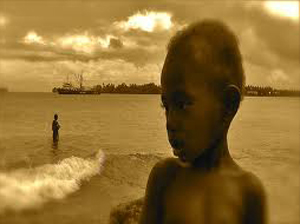
Presenter Jemima Garrett
MELBOURNE (Radio Australia/Pacific Media Watch): Papua New Guinea's National Court has rejected an application for a permanent halt to the use of deep sea waste disposal by the $1.5 billion Chinese-owned Ramu nickel mine, near Madang.
Dr Amanda Reichelt-Brushett, from Australia's Southern Cross University, was one of the scientists who gave evidence in the case and whose work Justice Cannings acknowledged in his judgement.
Dr Reichelt-Brushett says there is the potential for thousands of marine species, including vital keystone species, to be adversely affected by the mine waste.
Presenter: Jemima Garrett
Speaker: Dr Amanda Reichelt-Brushett, lecturer in the School of Envrionmental Science and Management, at Southern Cross University.
REICHELT-BRUSHETT: It's a 2-phased approach. It could be deeper at the disposal site but also there is potential for those tailings to be redistributed up into the higher water column and just small shifts in turbidity will influence coral survival and they are keystone species of coral reefs so we could potentially have impacts on the
larger coral reef structure.
GARRETT: Madang is a biodiversity hotspot. What will be particularly at risk from this court decision?
REICHELT-BRUSHETT: Well the unknowns are really what the risk is and Judge Cannings did state very clearly that there is going to be harm and he acknowledged that there is going to be environmental consequences and damage to the ecology of Astrolabe Bay and other coastal waters so the people in Papua New Guinea depend on those waters for their livelihood and their food security so its not just environment-its peoples' lives that are potentially at risk here.
GARRETT: Papua New Guinea's Environment department is being upgraded and it has new guidelines governing deep sea waste disposal. Does the Environment department have enough resources and expertise to monitor what is coming out of Ramu Nickel's waste pipe?
REICHELT-BRUSHETT: Well, tailings are an extremely complex mixture and scientists today don't fully understand what happens geochemically under the deep sea and more than 100 metres deep. That is beyond our capacity as scuba divers and also, all the testing that was done in the environmental plan on their own. Now, what the approval of the current government has enabled is that the waste from the actual mine itself, and the mine communities, so all the sewage and so on, which adds an organic load and potentially shift the geochemistry of that environment. So to have that depth of understanding and to understand processes as well as to collect that information at such an extreme depth isn't easy and often those responses have to be quite rapid. I would be thinking that an independent scientific review panel would be a helpful ole that could be used to make those decisions and ensure there is some environmental protection there.
GARRETT: If there is a problem, say a major spill of unexpected material going down this pipe, just how easy is it to fix?
REICHELT-BRUSHETT: Well, that's the unfortunate thing. It's a very high risk operation and, unlike on-land tailings where you can have management in place and management reaction to spills and incidents, there is not much that can be done. Perhaps you can stop it but if the harm has already been caused and the transport of waste is unlike that perceived, you can't go and collect up the ocean and put it back on land, so it is a case of too late.
GARRETT: This is not the only project looking at deep sea waste disposal. The Yandera copper project, which is also quite near Madang, is looking at putting five times as much waste, 25 million tonnes a year, down a pipe into the sea. What impact would you expect that to have?
REICHELT-BRUSHETT: Well, I really hope this doesn't set a precedent to enable that to happen. It is a different mine, that means there will be different waste products and different toxicity associated with that waste material and the location, and depth of the location, and where the canyons are placed will all influence it, so a proper environmental study, if that was to be pursued, would be required. I would like to think this court case would have, at least, alerted the mining companies to have a very, very stringent environmental plan in place that will recognise the importance of the environment to the local community.
GARRETT: We have seen environmental disasters on land from mining in Papua New Guinea, such as the Ok Tedi mine and its effects on the Fly River. What is the potential, with this new push for deep sea disposal, for a similar underwater disaster?
REICHELT-BRUSHETT: There is always a risk and because the risk is so high the uncertainty is high and you are taking a gamble, much more than you could if you had a very well-engineered and well-structured, land-based holding capacity. So the potential for environmental damage is extreme because the environment that you are disposing into is unknown.
AUDIO: Go to Radio Australia



